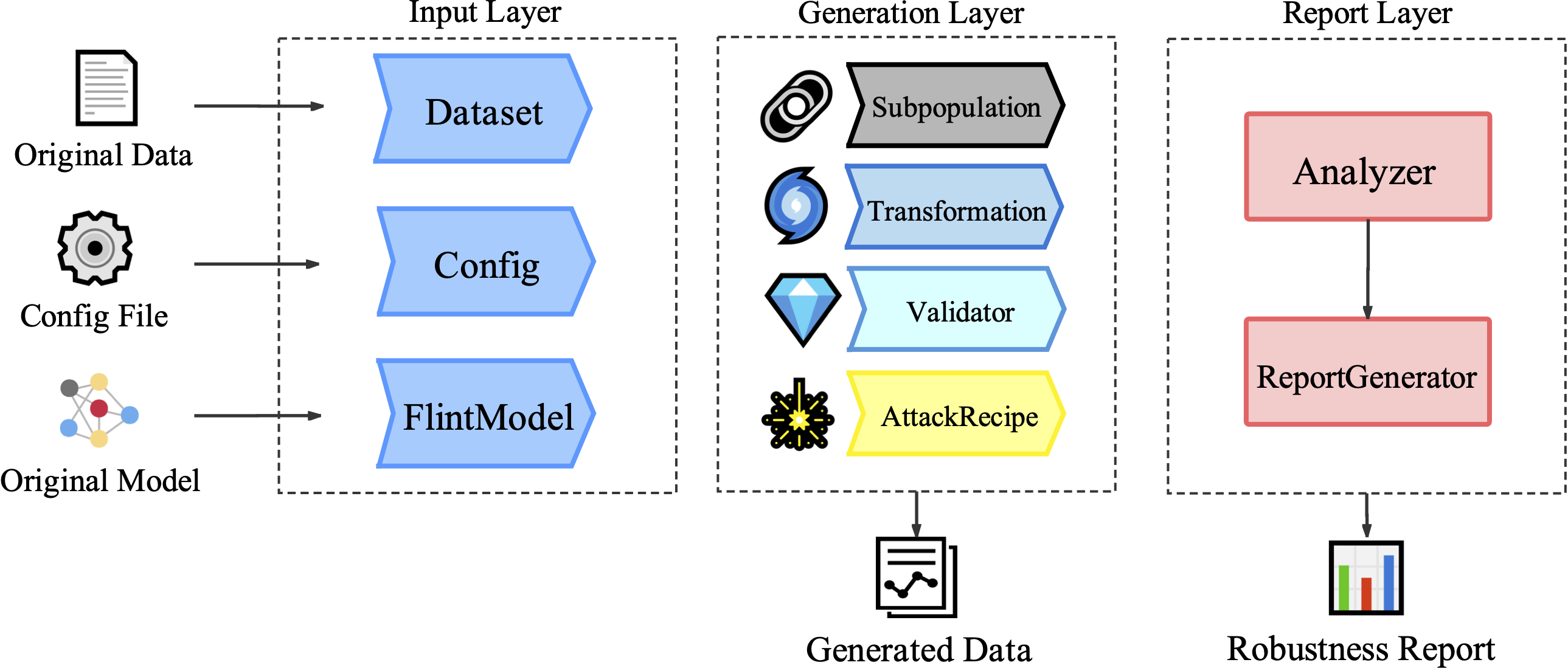textflint
Unified Multilingual Robustness Evaluation Toolkit for Natural Language Processing
TextFlint is a multilingual robustness evaluation platform for natural language processing, which unifies text transformation, sub-population, adversarial attack,and their combinations to provide a comprehensive robustness analysis. So far, TextFlint supports 13 NLP tasks.
If you're looking for robustness evaluation results of SOTA models, you might want the TextFlint IO page.
Features
- Full coverage of transformation types, including 20 general transformations, 8 subpopulations and 60 task-specific transformations, as well as thousands of their combinations.
- Subpopulation, which is to identify the specific part of dataset on which the target model performs poorly.
- Adversarial attack aims to find a perturbation of an input text that is able to fool the given model.
- Complete analytical report to accurately explain where your model's shortcomings are, such as the problems in lexical rules or syntactic rules.
Online Demo
You can test most of transformations directly on our online demo.
Setup
Require python version >= 3.7, recommend install with pip.
pip install textflint
Once TextFlint is installed, you can run it via command-line (textflint ...) or integrate it inside another NLP project.
Usage
Workflow

The general workflow of TextFlint is displayed above. Evaluation of target models could be divided into three steps:
- For input preparation, the original dataset for testing, which is to be loaded by
Dataset, should be firstly formatted as a series ofJSONobjects. You can use the built-inDatasetfollowing this instruction. TextFlint configuration is specified byConfig. Target model is also loaded asFlintModel. - In adversarial sample generation, multi-perspective transformations (i.e., 80+Transformation, Subpopulation and AttackRecipe), are performed on
Datasetto generate transformed samples. Besides, to ensure semantic and grammatical correctness of transformed samples, Validator calculates confidence of each sample to filter out unacceptable samples. - Lastly,
Analyzercollects evaluation results andReportGeneratorautomatically generates a comprehensive report of model robustness.
For example, on the Sentiment Analysis (SA) task, this is a statistical chart of the performance ofXLNET with different types of Transformation/Subpopulation/AttackRecipe on the IMDB dataset.

We release tutorials of performing the whole pipeline of TextFlint on various tasks, including:
- Machine Reading Comprehension
- Part-of-speech Tagging
- Named Entity Recognition
- Chinese Word Segmentation
Quick Start
Using TextFlint to verify the robustness of a specific model is as simple as running the following command:
$ textflint --dataset input_file --config config.json
where input_file is the input file of csv or json format, config.json is a configuration file with generation and target model options. Transformed datasets would save to your out dir according to your config.json.
Based on the design of decoupling sample generation and model verification, TextFlint can be used inside another NLP project with just a few lines of code.
from textflint import Engine
data_path = 'input.json'
config = 'config.json'
engine = Engine()
engine.run(data_path, config)
For more input and output instructions of TextFlint, please refer to the IO format document.
Architecture

Input layer: receives textual datasets and models as input, represented as Dataset and FlintModel separately.
DataSet: a container, provides efficient and handy operation interfaces forSample.Datasetsupports loading, verification, and saving data in Json or CSV format for various NLP tasks.FlintModel: a target model used in an adversarial attack.
Generation layer: there are mainly four parts in generation layer:
Subpopulation: generates a subset of aDataSet.Transformation: transforms each sample ofDatasetif it can be transformed.AttackRecipe: attacks theFlintModeland generates aDataSetof adversarial examples.Validator: verifies the quality of samples generated byTransformationandAttackRecipe.
textflint provides an interface to integrate the easy-to-use adversarial attack recipes implemented based on
textattack. Users can refer to textattack for more information about the supportedAttackRecipe.
Report layer: analyzes model testing results and provides robustness report for users.
Learn More
| Section | Description |
|---|---|
| Documentation | Full API documentation and tutorials |
| Tutorial | The tutorial of textflint components and pipeline |
| Website | Provides evaluation results of SOTA models and transformed data download |
| Online Demo | Interactive demo to try single text transformations |
| Paper | Our system paper which was received by ACL2021 |
Citation
If you are using TextFlint for your work, please kindly cite our ACL2021 TextFlint demo paper:
@article{wangtextflint,
title={TextFlint: Unified Multilingual Robustness Evaluation Toolkit for Natural Language Processing},
author={Wang, Xiao and Liu, Qin and Gui, Tao and Zhang, Qi and Zou, Yicheng and Zhou, Xin and Ye, Jiacheng and Zhang, Yongxin and Zheng, Rui and Pang, Zexiong and others}
}






